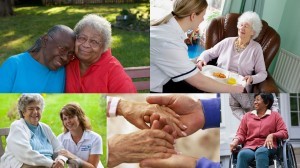
To maintain a professional distance, you should always remember that your
relationships with your clients are professional, not personal.
Defining the Relationship and the Different Types
| Social Relationships | Work Related Relationships | Client/Caregiver Relationships | |
| Purpose | Meets a person’s need for socialization: friendship/intimacy. | Meets the person’s need for success and achievement at work. | Meets client’s physical and emotional needs. |
| Goals | Socialization, companionship, sharing of ideas, emotion connection | Meeting work place goals and standards. | Client’s needs are identified and a plan is developed and put into action. |
| What do you talk about? | Exchange personal information and advice | Work related topics, meetings, clients, professional achievements. | Solutions to problems and a plan to meet client’s needs. |
| Outcome | Need for socialization, emotional satisfaction and security is met. | Mutual respect, trust, peaceful and productive work environment. | Client’s needs are met. Client develops coping skills. Client develops independence. |
But remember, the goal of professional relationships is to maintain a professional distance!
 The Chart above depicts the basic human needs. The physiological and safety levels must be met before the other can be reached.
The Chart above depicts the basic human needs. The physiological and safety levels must be met before the other can be reached.Example: If a person is not sleeping well, it doesn’t matter that they are not achieving their goals. It’s all about balance: We need to give enough help with basic physical needs so that our clients have the energy to focus on other needs. We need to allow our clients to take care of themselves as much as possible so they can remain independent and feel good about themselves.
You may NOT be keeping a Professional Distance if you:
- Think about a client frequently when you are away from work
- Plan your work day around the needs of the client
- Spend free time with a client
- Share personal information and concerns about work with a client
- Feel responsible if your client’s condition doesn’t improve
- Give extra care to one client over another
- Keep secrets for a client or share your own
- Trade assignments with co-workers so you can be with a certain client
- Accept gifts or money from a client
- Give a client your address and phone number
- Complain about your own health to a client
- Dress a certain way for a client
- Gossip about co-workers with a client
- Visit clients in their home when you are not scheduled to be with them
What harm is it to make friends with a client?
- Clients can feel hurt if your schedule changes and you take another assignment.
- They may not trust the new caregiver and their health can deteriorate.
- If you perform little “extras” for a client that are not a part of the care plan, they will expect the same special treatment from other caregivers and can treat other caregivers negatively due to this.
- Clients may come to depend on you too much rather than learning to cope on their own.
- You may find it hard to observe changes in your client because you have gotten too close to the situation.
Have you crossed the line? Ask yourself:
- Am I acting in my client’s best interest?
- Would I feel comfortable telling a co-worker about what I am doing?
- Would the client’s family approve of what I am doing?
- Am I following the client’s plan of care?
- Am I following BrightStar’s policies and procedures of proper conduct?
Ways to Maintain Professional Distance and give power back to clients: | ||||||||||||||
|
Final Do's and Don't's to remember:
Do:- Address your client by the name they prefer
- Listen to the concerns of the family and act on the concerns when appropriate
- Encourage your client to participate in their own care by following the care plan
- Call your client pet names
- Perform any duties outside the care plan
- Accept ANY gifts
- Disclose personal information about your life
- Discuss your feelings about your co-workers or BrightStar

